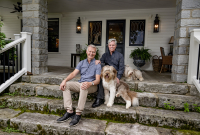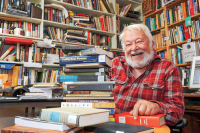Sponsored: Architectural News with Tab Bonidy
With decades of experience in the world of architecture, TAB Associates are leaders in the industry. Firm CEO, Tab Bonidy, sat down with Rumble to offer his knowledge and advice in regard to working with an architect.
Tragedy at Frank Lloyd Wright’s house
 In this story, I am God. — Frank Lloyd Wright
In this story, I am God. — Frank Lloyd Wright
The title of this nonfiction work, Death in a Prairie House, is misleading since it suggests that it is the latest offering from a crime fiction writer. While the title is appropriate, the actual subject discussed by William R. Drennan is much more. It is one of the most provocative mysteries in the history of American crime: the murders of seven people on August 5, 1914, in Frank Lloyd Wright’s famed “love nest, “Taliesin” in Spring Green, Wisconsin.
Where art meets architecture
 Sam Olbekson has never met a duality he couldn’t reconcile. As the lead architect for the $110 million Harrah’s Cherokee Valley River Casino & Hotel opening near Murphy next week, Olbekson’s design will make a lasting impression of the region on millions of visitors for decades to come.
Sam Olbekson has never met a duality he couldn’t reconcile. As the lead architect for the $110 million Harrah’s Cherokee Valley River Casino & Hotel opening near Murphy next week, Olbekson’s design will make a lasting impression of the region on millions of visitors for decades to come.
When it all clicks — the art of the angle
 John MacLean will never forget his first photo shoot.
John MacLean will never forget his first photo shoot.
“I was 19 years old and it was at a meat packing plant in New Jersey,” he said.
Standing in the basement of the Cullowhee Methodist Church at Western Carolina University last Saturday, MacLean told two-dozen folks of the Sylva Photo Club about how he got into the business.
Waynesville pays homage to historic character with new guidelines
 Building owners in Waynesville’s historic districts may have to jump through extra hoops before undertaking renovations or alterations to their property in an effort to retain the town’s historic character.
Building owners in Waynesville’s historic districts may have to jump through extra hoops before undertaking renovations or alterations to their property in an effort to retain the town’s historic character.
Enamored with stacked stone and timber, planners push mountain look
Western North Carolina has so embraced mountain vernacular architecture that local planning boards across the area are prodding developers into adopting the style.
While officials stop short of handing over a checklist to architects that includes stacked stone, steep pitched roofs and exposed timbers, they strongly encourage using natural materials and earthy colors. The result seems to be an overall rise in mountain-style architecture in areas that promote them.
So far, such appearance standards have been adopted in Waynesville, Cashiers, Cherokee, and a section of U.S. 441 in Jackson County that leads to Cherokee.
Maggie Valley hopes to jump on the bandwagon, with a planning board now ruminating on a draft of land development standards.
The planning boards that adopt these policies don’t see them as dictatorial. They say the policies promote a cohesive look that is both attractive and good for tourism. Moreover, mountain-style architecture is representative of Western North Carolina and connotes a sense of place.
“It’s who we are,” said Linda Cable, planning director for Jackson County. “It blends in with the nature, the geography and the scenery.”
The quest for harmony
Places that have adopted design standards all seem to echo the mountain theme. Some encourage, others mandate principles like these:
• warm, natural colors like beige, dark green and brown, rather than flamboyant colors like hot pink or neon green.
• articulated frontages with windows, porticos or varying color tones, rather than flat, monotonous building fronts.
• natural siding like wood, log, native stone, or brick, rather than vinyl or stucco.
Brandon Stephens, building construction manager for the Eastern Band of Cherokee Indians, said Cherokee’s building standards mainly discourage architecture that is discordant with the mountain environs.
“What we’re trying to go for is those colors that complement the mountains,” said Stephens. “Anything from dirt to the leaves on trees.”
According to Cable, these kinds of standards are appropriate for communities that would like to maintain a mountain character as they grow.
Cable denied that the design standards scare off developers from the region.
“I don’t think that’s an issue,” said Cable. “Once a company understands that a community has guidelines, then they are willing to modify their plans.”
One example of a corporate giant’s compliance is the Wendy’s that was developed in Cashiers under the standards. It features heavy rock work and a sign with more subdued colors than the company’s usual vivid red logo.
The new Wal-Mart in Waynesville also bowed down to the town’s community appearance commission’s demands a few years ago.
After the company’s architects offered the same-old big-box design for its new location, the commission sternly pointed them back to the drawing board.
That’s when Patrick Bradshaw, an engineer in Waynesville, took the Wal-Mart architects on a 30-minute whirlwind driving tour of the town to give them a flavor of what the commission members desired.
Wal-Mart’s architects came back with a better understanding of the town’s vision, bringing with them a design that incorporated ornamental exposed timber beams, stacked stone entryways, and more neutral, natural colors, successfully winning commission members’ hearts.
No “hard and fast”
Though many businesses have opted for mountain-style architecture under the appearance standards, towns have been flexible enough to allow wholly different looks.
Mib Medford, a member of the Waynesville Community Appearance Commission, stressed there is no “hard and fast” with the standards since they are simply guidelines.
Though design standards give businesses various options for complying, some styles will fit in better than others.
Bradshaw pointed out that both Wal-Mart and the much more contemporary McDonald’s in Waynesville were developed under the same standards. But it’s obvious to him that Wal-Mart’s design fits in better with the town’s character.
“Which one makes you feel like you’re in the mountains?” asked Bradshaw.
Maggie Valley, which is following the lead of towns like Waynesville and Cashiers, is still working on drafting the best possible design standards for future construction and major renovations.
Maggie Valley’s planning director Nathan Clark said the town’s mantra would be “ballpark, not bulls-eye,” allowing for accommodations in design rather than requiring every building to feature mountain-style.
“It’s not cut and dry, where everything has to be a Swiss chalet,” said Clark. “We still want to have some of that Maggie Valley individual style and flair.”
Clark says Maggie Valley’s proposed design standards would give the town a “new spark” that would jumpstart its tourism-dependent economy.
Tracing the roots of WNC’s signature style
Love it or hate it, mountain vernacular architecture has stubbornly planted its roots in Western North Carolina and shows no signs of abandoning the area.
The style that favors steep pitched roofs, native stonework, timber frame gables and earth-tone colors has manifested itself in homes, schools, police and fire departments, and even chains like Wal-Mart and Wendy’s.
Part of the popularity is fueled simply by aesthetic preference, but in some cases, developers were goaded into adopting the style by towns striving for architectural unity.
Local governments are certainly not exempting themselves from the trend. Testaments to their penchant for the style include Waynesville’s new fire station and town hall, the Lake Junaluska Welcome Center, Jackson County’s new senior center and Cherokee’s new $140 million school.
Like chalets dominate our notion of Switzerland, and sand-colored stucco defines the Southwest, mountain vernacular architecture has grown to become a quintessential look for Western North Carolina.
Though architects agree the style hearkens back to WNC’s early days, they clash on what exactly led to its extensive revival.
Where’d it come from?
Plain old common sense gave shape to the mountain-style architecture that cropped up here more than a century ago.
Pitched roofs channeled off rain and snow, while timber beams were hewed from the woods around them and stones were churned up and tossed aside when plowing fields.
“Native stone is what people from past generations would go out and pick up,” said Randy Cunningham, an architect with Waynesville-based Mountain Design.
“They had it. It was at hand. It was free,” said Mib Medford, who sits on the Waynesville community appearance commission. “Availability is what brought it on.”
Mountain-style architecture is probably an original colonial invention, according to Sylva-based architect O’Dell Thompson. It’s neither inspired by Native American techniques nor European architectural traditions, which uses stone a lot more heavily, Thompson said.
Whatever the reason for its initial adoption by WNC settlers, the style has won over a crowd of architects, business owners and residents over the last 20 years.
Now, it’s become nearly impossible to go anywhere without running into stacked stones inspired by the foundations of old farmhouses or timber frames that recall exposed rafters in barns.
“It’s running rampant, that kind of look. It’s everywhere,” said Scott Donald, an architect with Padgett & Freeman Architects who has designed many mountain-style buildings in Cherokee.
Local architects have multiple theories for why that is.
Luis Quevedo at Waynesville-based LQ Design Options, stressed that there was no sudden explosion of mountain-style architecture here. It evolved over time.
Quevedo said it could have been influenced by architecture in the Rocky Mountain region.
“There’s a lot of influence that comes from out West,” said Quevedo, adding that the contemporary version of the style has been popular in the West for a lot longer.
The main difference between the two regions, he said, is that the Southern Appalachian region often incorporates a native barn look.
Thompson agreed, stating that WNC’s mountain architecture isn’t fundamentally different from the kind found in states like Colorado, Idaho, and Montana, which took their cue from the Alps. But the Smoky Mountain brand of mountain architecture is simpler and more understated than all of the above, said Thompson.
According to Donald, the credit for the mountain look historically lies with the East, not the other way around.
“We’d already set the standards here in the East before it went West,” said Donald.
Donald said it’s possible that people who flocked to national parks during vacations caught inspiration from the lodges there. They returned, wanting to craft a similar look for their own homes.
In Thompson’s view, outsiders moving into the area about 20 years ago were primarily responsible for reviving the rustic look.
“When people started discovering the mountains as a place to retire to, they started wanting homes that felt like they belonged,” said Thompson.
Though many architects are fans of mountain-style architecture, not all agree with its proliferation. For example, Donald doesn’t find the style appropriate for the Haywood County jail or Wal-Mart.
“If you just slap a gable onto the front of a Wal-Mart, I don’t think that’s appropriate,” said Donald. “If you’re going to do it, do it. Don’t just do a piece of it. It suggests something it’s not.”
Architects say there’s definitely a right way and a wrong way to create the look.
Quevedo is not exactly a fan of what he calls the “cookie-cutter log homes” he sees in Maggie Valley. He said he prefers a more authentic rustic style.
The green connection
Part of the driving force behind that rustic style is the green movement, which encourages using local, sustainable products wherever possible. Many are drawn to the idea of harvesting natural materials to create a mountain look.
Quevedo said he has often used native stone, heavy timber, and even logs as columns or handrails.
Architects can create a very basic mountain look or take it to the extreme, by using tree bark for siding, for example.
“You think of tree bark, that’s what protects the tree for hundreds of years, why not put it on the side of the house?” said Donald.
Natural materials, or at least the natural look, are inseparable from mountain-style architecture, which Donald calls the complete opposite of the “smooth high-tech commercial look.”
Some who opt for the style hunt down and recycle parts from old buildings, for example, to lend a more authentic, traditional appearance for their new construction. Architects have been especially inspired by barn wood.
Local companies have sprung up to cater to their tastes, specializing in buying old barns and extracting materials to use as flooring, siding, railings and columns in new homes, Quevedo said.
Ironically, a lot of stone used to recreate an indigenous look comes from outside the region, according to Cunningham.
No matter the appeal, there are undeniable downsides to using recycled material. Maintenance and cost are two major sticking points.
“Recycled wood and recycled materials are not cheap,” said Quevedo. “You end up spending top dollar sometimes.”
Those who choose to use recycled wood must make sure it is treated properly, and even after everything has been installed, the time to do routine maintenance will come around a lot quicker than if new materials had been used.
Developers must take great care to make sure the building is waterproof, while dwellers must replace mortar between the rocks every 30 to 40 years, Donald said.
Though the actual buildings obviously won’t last forever, most architects seem to shoot for a look that never grows old. Again and again, they said they were concerned with creating something that wasn’t solely “trendy.”
“In my opinion, when you lock into a style, then you’ve locked into something that will go out of style,” said Thompson. “It’s more important for it to be timeless.”





